Sha Yi
Co-Design of Soft Gripper with Neural Physics
May 26, 2025Abstract:For robot manipulation, both the controller and end-effector design are crucial. Soft grippers are generalizable by deforming to different geometries, but designing such a gripper and finding its grasp pose remains challenging. In this paper, we propose a co-design framework that generates an optimized soft gripper's block-wise stiffness distribution and its grasping pose, using a neural physics model trained in simulation. We derived a uniform-pressure tendon model for a flexure-based soft finger, then generated a diverse dataset by randomizing both gripper pose and design parameters. A neural network is trained to approximate this forward simulation, yielding a fast, differentiable surrogate. We embed that surrogate in an end-to-end optimization loop to optimize the ideal stiffness configuration and best grasp pose. Finally, we 3D-print the optimized grippers of various stiffness by changing the structural parameters. We demonstrate that our co-designed grippers significantly outperform baseline designs in both simulation and hardware experiments.
Humanoid Policy ~ Human Policy
Mar 17, 2025Abstract:Training manipulation policies for humanoid robots with diverse data enhances their robustness and generalization across tasks and platforms. However, learning solely from robot demonstrations is labor-intensive, requiring expensive tele-operated data collection which is difficult to scale. This paper investigates a more scalable data source, egocentric human demonstrations, to serve as cross-embodiment training data for robot learning. We mitigate the embodiment gap between humanoids and humans from both the data and modeling perspectives. We collect an egocentric task-oriented dataset (PH2D) that is directly aligned with humanoid manipulation demonstrations. We then train a human-humanoid behavior policy, which we term Human Action Transformer (HAT). The state-action space of HAT is unified for both humans and humanoid robots and can be differentiably retargeted to robot actions. Co-trained with smaller-scale robot data, HAT directly models humanoid robots and humans as different embodiments without additional supervision. We show that human data improves both generalization and robustness of HAT with significantly better data collection efficiency. Code and data: https://human-as-robot.github.io/
Mobile-TeleVision: Predictive Motion Priors for Humanoid Whole-Body Control
Dec 10, 2024



Abstract:Humanoid robots require both robust lower-body locomotion and precise upper-body manipulation. While recent Reinforcement Learning (RL) approaches provide whole-body loco-manipulation policies, they lack precise manipulation with high DoF arms. In this paper, we propose decoupling upper-body control from locomotion, using inverse kinematics (IK) and motion retargeting for precise manipulation, while RL focuses on robust lower-body locomotion. We introduce PMP (Predictive Motion Priors), trained with Conditional Variational Autoencoder (CVAE) to effectively represent upper-body motions. The locomotion policy is trained conditioned on this upper-body motion representation, ensuring that the system remains robust with both manipulation and locomotion. We show that CVAE features are crucial for stability and robustness, and significantly outperforms RL-based whole-body control in precise manipulation. With precise upper-body motion and robust lower-body locomotion control, operators can remotely control the humanoid to walk around and explore different environments, while performing diverse manipulation tasks.
ACE: A Cross-Platform Visual-Exoskeletons System for Low-Cost Dexterous Teleoperation
Aug 21, 2024

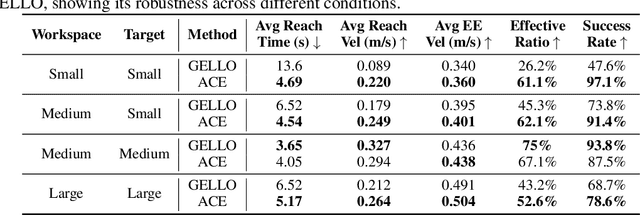

Abstract:Learning from demonstrations has shown to be an effective approach to robotic manipulation, especially with the recently collected large-scale robot data with teleoperation systems. Building an efficient teleoperation system across diverse robot platforms has become more crucial than ever. However, there is a notable lack of cost-effective and user-friendly teleoperation systems for different end-effectors, e.g., anthropomorphic robot hands and grippers, that can operate across multiple platforms. To address this issue, we develop ACE, a cross-platform visual-exoskeleton system for low-cost dexterous teleoperation. Our system utilizes a hand-facing camera to capture 3D hand poses and an exoskeleton mounted on a portable base, enabling accurate real-time capture of both finger and wrist poses. Compared to previous systems, which often require hardware customization according to different robots, our single system can generalize to humanoid hands, arm-hands, arm-gripper, and quadruped-gripper systems with high-precision teleoperation. This enables imitation learning for complex manipulation tasks on diverse platforms.
Decentralized Multi-Robot Line-of-Sight Connectivity Maintenance under Uncertainty
Jun 18, 2024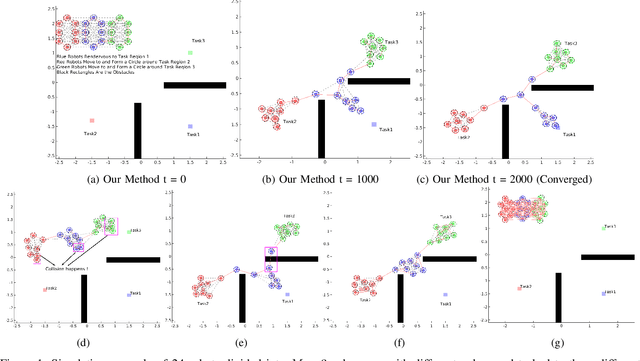



Abstract:In this paper, we propose a novel decentralized control method to maintain Line-of-Sight connectivity for multi-robot networks in the presence of Guassian-distributed localization uncertainty. In contrast to most existing work that assumes perfect positional information about robots or enforces overly restrictive rigid formation against uncertainty, our method enables robots to preserve Line-of-Sight connectivity with high probability under unbounded Gaussian-like positional noises while remaining minimally intrusive to the original robots' tasks. This is achieved by a motion coordination framework that jointly optimizes the set of existing Line-of-Sight edges to preserve and control revisions to the nominal task-related controllers, subject to the safety constraints and the corresponding composition of uncertainty-aware Line-of-Sight control constraints. Such compositional control constraints, expressed by our novel notion of probabilistic Line-of-Sight connectivity barrier certificates (PrLOS-CBC) for pairwise robots using control barrier functions, explicitly characterize the deterministic admissible control space for the two robots. The resulting motion ensures Line-of-Sight connectedness for the robot team with high probability. Furthermore, we propose a fully decentralized algorithm that decomposes the motion coordination framework by interleaving the composite constraint specification and solving for the resulting optimization-based controllers. The optimality of our approach is justified by the theoretical proofs. Simulation and real-world experiments results are given to demonstrate the effectiveness of our method.
Reconfigurable Robot Control Using Flexible Coupling Mechanisms
Jun 28, 2023Abstract:Reconfigurable robot swarms are capable of connecting with each other to form complex structures. Current mechanical or magnetic connection mechanisms can be complicated to manufacture, consume high power, have a limited load-bearing capacity, or can only form rigid structures. In this paper, we present our low-cost soft anchor design that enables flexible coupling and decoupling between robots. Our asymmetric anchor requires minimal force to be pushed into the opening of another robot while having a strong pulling force so that the connection between robots can be secured. To maintain this flexible coupling mechanism as an assembled structure, we present our Model Predictive Control (MPC) frameworks with polygon constraints to model the geometric relationship between robots. We conducted experiments on the soft anchor to obtain its force profile, which informed the three-bar linkage model of the anchor in the simulations. We show that the proposed mechanism and MPC frameworks enable the robots to couple, decouple, and perform various behaviors in both the simulation environment and hardware platform. Our code is available at https://github.com/ZoomLabCMU/puzzlebot_anchor . Video is available at https://www.youtube.com/watch?v=R3gFplorCJg .
Configuration Control for Physical Coupling of Heterogeneous Robot Swarms
Mar 01, 2022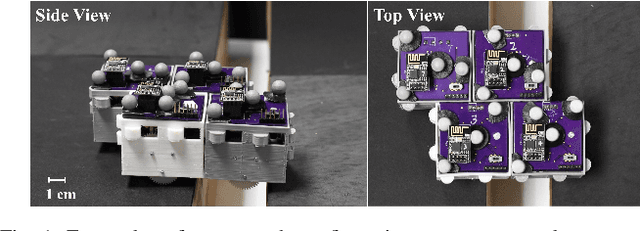
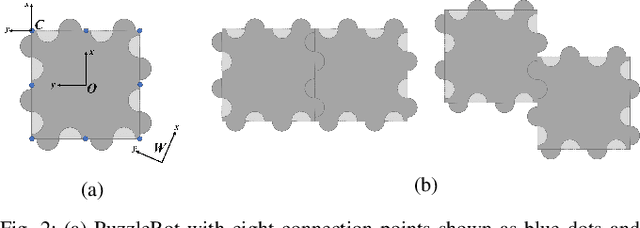
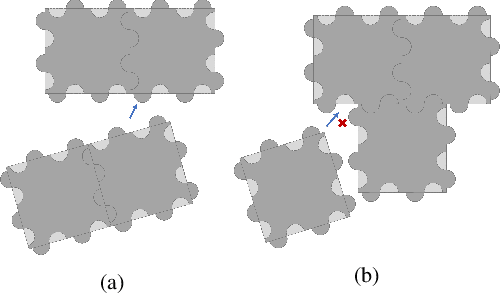

Abstract:In this paper, we present a heterogeneous robot swarm system that can physically couple with each other to form functional structures and dynamically decouple to perform individual tasks. The connection between robots can be formed with a passive coupling mechanism, ensuring minimum energy consumption during coupling and decoupling behavior. The heterogeneity of the system enables the robots to perform structural enhancement configurations based on specific environmental requirements. We propose a connection-pair oriented configuration control algorithm to form different assemblies. We show experiments of up to nine robots performing the coupling, gap-crossing, and decoupling behaviors.
PuzzleBots: Physical Coupling of Robot Swarms
Feb 06, 2022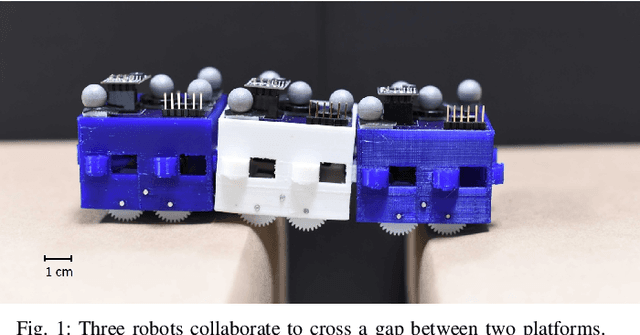


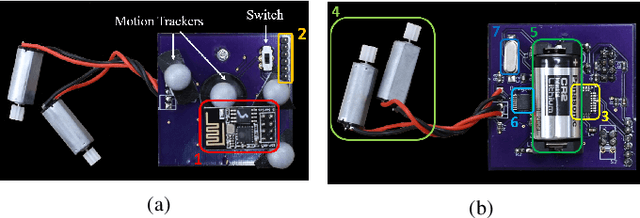
Abstract:Robot swarms have been shown to improve the ability of individual robots by inter-robot collaboration. In this paper, we present the PuzzleBots - a low-cost robotic swarm system where robots can physically couple with each other to form functional structures with minimum energy consumption while maintaining individual mobility to navigate within the environment. Each robot has knobs and holes along the sides of its body so that the robots can couple by inserting the knobs into the holes. We present the characterization of knob design and the result of gap-crossing behavior with up to nine robots. We show with hardware experiments that the robots are able to couple with each other to cross gaps and decouple to perform individual tasks. We anticipate the PuzzleBots will be useful in unstructured environments as individuals and coupled systems in real-world applications.
Behavior Mixing with Minimum Global and Subgroup Connectivity Maintenance for Large-Scale Multi-Robot Systems
Oct 03, 2019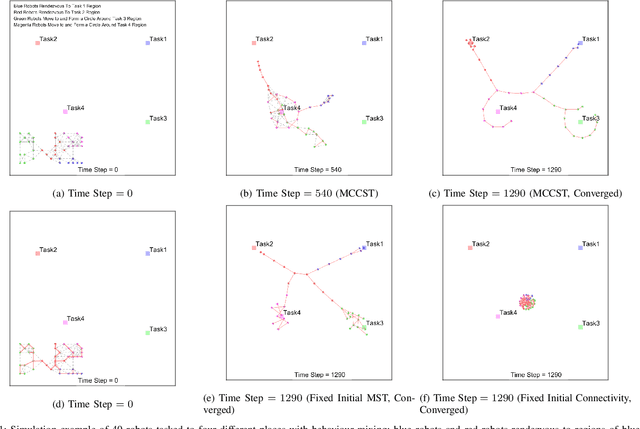


Abstract:In many cases the multi-robot systems are desired to execute simultaneously multiple behaviors with different controllers, and sequences of behaviors in real time, which we call \textit{behavior mixing}. Behavior mixing is accomplished when different subgroups of the overall robot team change their controllers to collectively achieve given tasks while maintaining connectivity within and across subgroups in one connected communication graph. In this paper, we present a provably minimum connectivity maintenance framework to ensure the subgroups and overall robot team stay connected at all time while providing the highest freedom for behavior mixing. In particular, we propose a real-time distributed Minimum Connectivity Constraint Spanning Tree (MCCST) algorithm to select the minimum inter-robot connectivity constraints preserving subgroup and global connectivity that are \textit{least likely to be violated} by the original controllers. With the employed control barrier functions for the activated connectivity constraints as well as collision avoidance, the behavior mixing controllers are thus modified in a minimally invasive manner. We demonstrate the effectiveness and scalability of our approach via simulations of up to 100 robots in presence of multiple behaviors.
 Add to Chrome
Add to Chrome Add to Firefox
Add to Firefox Add to Edge
Add to Edge